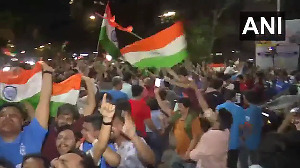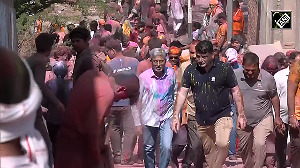Astronauts aboard the International Space Station had to abandon solar panel repair efforts and leave it halfway retracted after seven long hours. They went ahead with the next steps in their mission to rewire the outpost's electrical system.
The folding of the 115-foot-long array was to set the stage for hooking up the ISS' permanent electricity-generating system during two spacewalks later this week.
However, mission controllers told the astronauts they were considering mounting a spacewalk later in the mission to manually retract the solar wing.
The International Space Station's newest set of solar arrays is tracking the sun on Thursday night, following partial retraction of a similar array that's been the station's primary power plant for six years.
This event sets the stage for two challenging spacewalks by the STS-116 crew to rewire and reroute the station's power system.
The Solar Alpha Rotary Joint and the new set of arrays are a part of the P3/ P4 truss segments that were installed onto the station in September during the STS-115 mission.
The rotary joint enables the solar arrays to follow the sun and generate the maximum power possible.
Activation of the SARJ occurred shortly before 8 pm EST, and a few minutes later the Mission Control Center in Houston notified the crew that the arrays were following the sun.
Throughout the day, the STS-116 crew and flight controllers worked together to solve problems that prevented the P6 truss port solar arrays from folding properly.
The retraction activities of the arrays began at 1:28 pm.
More than 40 commands were sent to furl and unfurl the arrays in an attempt to properly align them.
When the efforts concluded about 7:50 pm, 13.5 of 31 bays had been folded, leaving the port arrays in a safe position that allowed the activation of the P4 rotary joint.
NASA has described Discovery's rewiring mission at the ISS as one of the most complex and difficult in the history of space flight.
Although the panel didn't fully retract, the path was cleared for the new arrays to rotate for the first time since they were installed.
"It's kind of like folding a map up," said Discovery's STS -116 commander Mark Polansky said as he watched the process. "You have the folds in the paper, and if you start folding it and the fold is going the wrong way, you can try a little bit but there gets a point where it just bows out and there's nothing you can do other than to pop it back in place or unfold it and try again."
That prompted astronauts aboard the ISS to retract the P6-4B array until an errant fold occurred, then extend the solar wing back out and try again, a technique that newly arrived ISS astronaut Indian-origin Sunita 'Suni' Williams said produced favourable results.
"Okay Suni, that's good news to hear. You've got a bunch of guys about to turn blue here," Robinson told the ISS crew, prompting laughs at NASA's Mission Control here since flight controllers said the same thing to Neil Armstrong and Buzz Aldrin after their 1969 Moon landing.






 © 2025
© 2025